Impact of High Inertia Particles on the Shock Layer and Heat Transfer in a Heterogeneous Supersonic Flow around a Blunt Body
Abstract
:1. Introduction
2. Model and Methods
3. Results and Discussion
4. Conclusions
Author Contributions
Funding
Informed Consent Statement
Conflicts of Interest
References
- Crowe, C.T.; Schwarzkopf, J.D.; Sommerfeld, M.; Tsuji, Y. Multiphase Flows with Droplets and Particles, 2nd ed.; CRC Press: New York, NY, USA, 2011. [Google Scholar]
- Mikhatulin, D.S.; Polezhaev, Y.V.; Reviznikov, D.L. Heat Transfer and Destruction of Bodies in a Supersonic Heterogeneous Flow; Yanus-K: Moscow, Russia, 2007. (In Russian) [Google Scholar]
- Tsirkunov, Y.M. Gas-particle flows around bodies–key problems, modeling and numerical analysis. In Proceedings of the Fourth International Conference on Multiphase Flow, New Orleans, LA, USA, 27 May–1 June 2001; Paper No 609. Michaelides, E., Ed.; p. 31. [Google Scholar]
- Varaksin, A.Y. Fluid dynamics and thermal physics of two-phase flows: Problems and achievements. High Temp. 2013, 51, 377–407. [Google Scholar] [CrossRef]
- Varaksin, A.Y. Gas-Solid Flows Past Bodies. High Temp. 2018, 56, 275–295. [Google Scholar] [CrossRef]
- Dombrovsky, L.A.; Baillis, D. Thermal Radiation in Disperse Systems: An Engineering Approach; Begell House: New York, NY, USA, 2010. [Google Scholar]
- Ershova, T.V.; Mikhatulin, D.S.; Reviznikov, D.L.; Sposobin, A.V.; Vinnikov, V.V. Numerical Simulation of Heat and Mass Transfer between Heterogeneous Flow and an Obstacle. Comput. Therm. Sci. 2011, 3, 15–30. [Google Scholar] [CrossRef]
- Vasilevsky, E.B.; Osiptsov, A.N.; Chirikhin, A.V.; Yakovleva, L.V. Heat transfer on the frontal surface of a blunt body in a high-speed flow containing low-inertia particles. J. Eng. Phys. J. 2001, 74, 1399–1411. [Google Scholar]
- Volkov, A.N.; Tsirkunov, Y.M.; Oesterle, B. Numerical simulation of a supersonic gas–solid flow over a blunt body: The role of inter-particle collisions and two-way coupling effects. Int. J. Multiph. Flow. 2005, 31, 1244–1275. [Google Scholar] [CrossRef]
- Oesterlé, B.; Volkov, A.N.; Tsirkunov, Y.M. Numerical investigation of two-phase flow structure and heat transfer in a supersonic dusty gas flow over a blunt body. Prog. Flight Phys. 2013, 5, 441–456. [Google Scholar]
- Osiptsov, A.N.; Egorova, L.A.; Sakharov, V.I.; Wang, B. Heat transfer in supersonic dusty-gas flow past a blunt body with inertial particle deposition effect. Prog. Nat. Sci. 2002, 12, 887–892. [Google Scholar]
- Reviznikov, D.L.; Sposobin, A.V.; Sukharev, T.Y. Numerical simulation of the flow around a blunt body in supersonic polydisperse stream. High Temp. 2017, 55, 400–406. [Google Scholar] [CrossRef]
- Molleson, G.V.; Stasenko, A.L. Acceleration of Microparticles and their Interaction with a Solid Body. High Temp. 2017, 55, 906–913. [Google Scholar] [CrossRef]
- Mironov, A.; Isaev, S.; Skrypnik, A.; Popov, I. Numerical and physical simulation of heat transfer enhancement using oval dimple vortex generators —Review and recommendations. Energies 2020, 13, 5243. [Google Scholar] [CrossRef]
- Isaev, S.A.; Popov, I.A.; Mikheev, N.I.; Guvernyuk, S.V.; Nikushchenko, D.V.; Sudakov, A.G. Heat transfer enhancement by surface vortex generators. New basic mechanisms and industrial technologies. J. Phys. Conf. Ser. 2020, 1683, 022084. [Google Scholar] [CrossRef]
- Fleener, W.A.; Watson, R.H. Convective heating in dust-laden hypersonic flows. AIAA Pap. 1973, 73–761. [Google Scholar] [CrossRef]
- Holden, M.; Duryea, G.; Gustafson, G.; Hudack, L. An Experimental Study of Particle-Induced Convective Heating Augmentation. AIAA Pap. 1976, 76–320. [Google Scholar] [CrossRef]
- Dunbar, L.E.; Courtney, J.F.; McMillen, L.D. Heating augmentation in Erosive Hypersonic Environments. AIAA J. 1975, 13, 908–912. [Google Scholar] [CrossRef]
- Hove, D.T.; Shih, W.C.L. Re-entry Vehicle Stagnation Region Heat Transfer in Particle Environments. AIAA J. 1977, 15, 1002–1005. [Google Scholar] [CrossRef]
- Vladimirov, A.S.; Ershov, I.V.; Makarevich, G.A.; Khodtsev, A.V. Experimental investigation of the process of interaction between heterogeneous flows and flying bodies. High Temp. 2008, 46, 512–517. [Google Scholar] [CrossRef]
- Reviznikov, D.L.; Sposobin, A.V.; Ivanov, I.E. Change in the Structure of a Flow under the Action of Highly Inertial Particle when a Hypersonic Heterogeneous Flow Passes over a Body. High Temp. 2018, 56, 884–889. [Google Scholar] [CrossRef]
- Reviznikov, D.L.; Sposobin, A.V.; Ivanov, I.E. Oscillatory flow regimes resulting from the shock layer-particle interaction. High Temp. 2020, 58, 278–283. [Google Scholar] [CrossRef]
- Reviznikov, D.L.; Sposobin, A.V.; Ivanov, I.E. Comparative Analysis of Calculated and Experimental Data on an Oscillating Flow Induced by the Gasdynamic Interaction of a Particle with a Shock Layer. High Temp. 2020, 58, 839–845. [Google Scholar] [CrossRef]
- Sposobin, A.V.; Reviznikov, D.L.; Ivanov, I.E.; Kryukov, I.A. Pressure and Heat Flux Oscillations Induced by Gas-Dynamic Interaction between a High Inertia Particle and a Shock Layer. Russ. Aeronaut. 2020, 63, 677–685. [Google Scholar] [CrossRef]
- Holden, M.S. Experimental Studies of Separated Flows at Hypersonic Speeds. Part I: Separated Flows over Axisymmetric Spiked Bodies. AIAA J. 1966, 4, 591–599. [Google Scholar] [CrossRef]
- Zapryagaev, V.I.; Kavun, I.N. Experimental study of the reverse flow in the forward separation region in a pulsating flow around a spiked body. J. Appl. Mech. Tech. Phys. 2007, 48, 492–500. [Google Scholar] [CrossRef]
- Kitamura, K.; Eiji, S. Evaluation of Euler Fluxes for Hypersonic Heating Computations. AIAA J. 2010, 48, 763–776. [Google Scholar] [CrossRef]
- Kitamura, K.; Eiji, S. Towards shock-stable and accurate hypersonic heating computations: A new pressure flux for AUSM-family schemes. J. Comput. Phys. 2013, 245, 62–83. [Google Scholar] [CrossRef]
- Kotov, D.V.; Surzhikov, S.T. Calculation of viscous and inviscid gas flows on unstructured grids using the AUSM scheme. Fluid Dyn. 2011, 46, 809–825. [Google Scholar] [CrossRef]
- Peskin, C.S. The immersed boundary method. Acta Numer. 2002, 11, 479–517. [Google Scholar] [CrossRef] [Green Version]
- Tseng, Y.H.; Ferziger, J.H. A ghost-cell immersed boundary method for flow in complex geometry. J. Comput. Phys. 2003, 192, 593–623. [Google Scholar] [CrossRef]
- Lima, E.; Silva, A.L.F.; Silveira-Neto, A.; Damasceno, J.J.R. Numerical simulation of two-dimensional flows over a circular cylinder using the immersed boundary method. J. Comput. Phys. 2003, 189, 351–370. [Google Scholar] [CrossRef]
- Bakhvalov, P.A.; Bobkov, V.G.; Kozubskaya, T.K. Application of schemes with a quasi-one-dimensional reconstruction of variables for calculations on nonstructured sliding grids. Math Models Comput. Simul. 2017, 9, 155–168. [Google Scholar] [CrossRef]
- Yamakawa, M.; Chikaguchi, S.; Asao, S.; Hamato, S. Multi Axes Sliding Mesh Approach for Compressible Viscous Flows. In Lecture Notes in Computer Science; Krzhizhanovskaya, V., Závodszky, G., Lees, M., Dongarra, J., Sloot, P., Brissos, S., Teixeira, J., Eds.; Computational Science–ICCS 2020; Springer: Cham, Switzerland, 2020; Volume 12143. [Google Scholar] [CrossRef]
- Dürrwächter, J.; Kurz, M.; Kopper, P.; Kempf, D.; Munz, C.D.; Beck, A. An efficient sliding mesh interface method for high-order discontinuous Galerkin schemes. Comput. Fluids 2021, 217, 104825. [Google Scholar] [CrossRef]
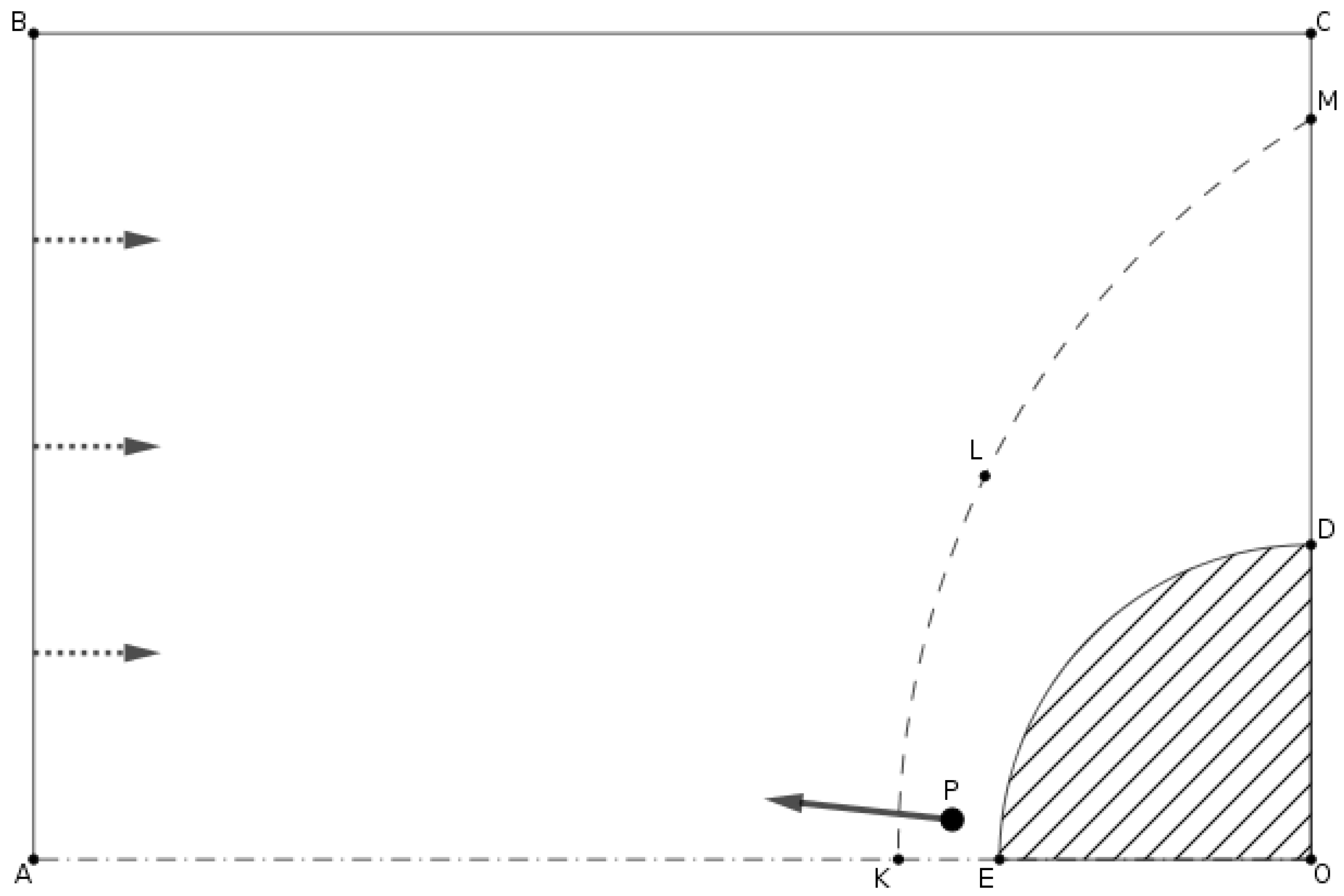
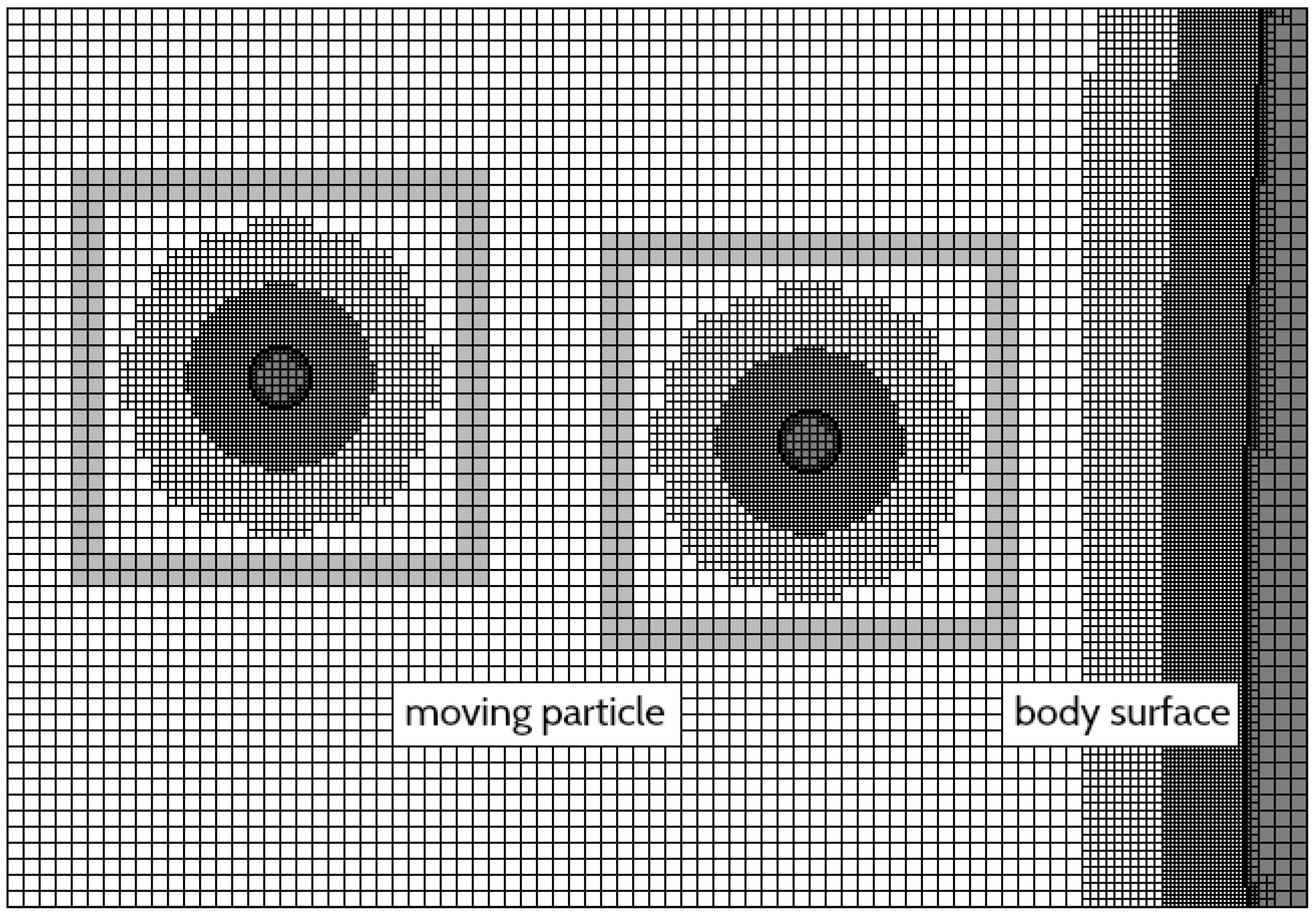
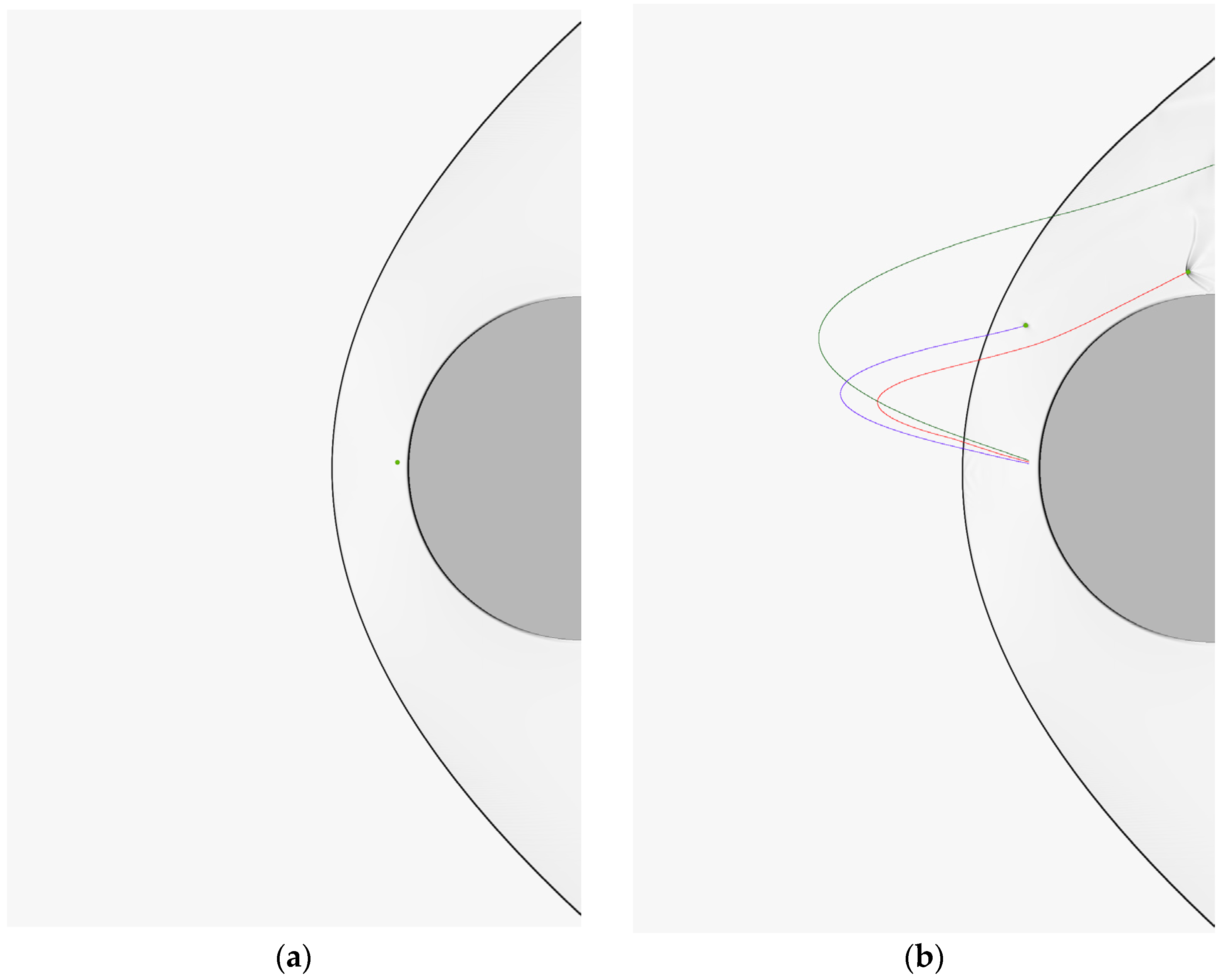
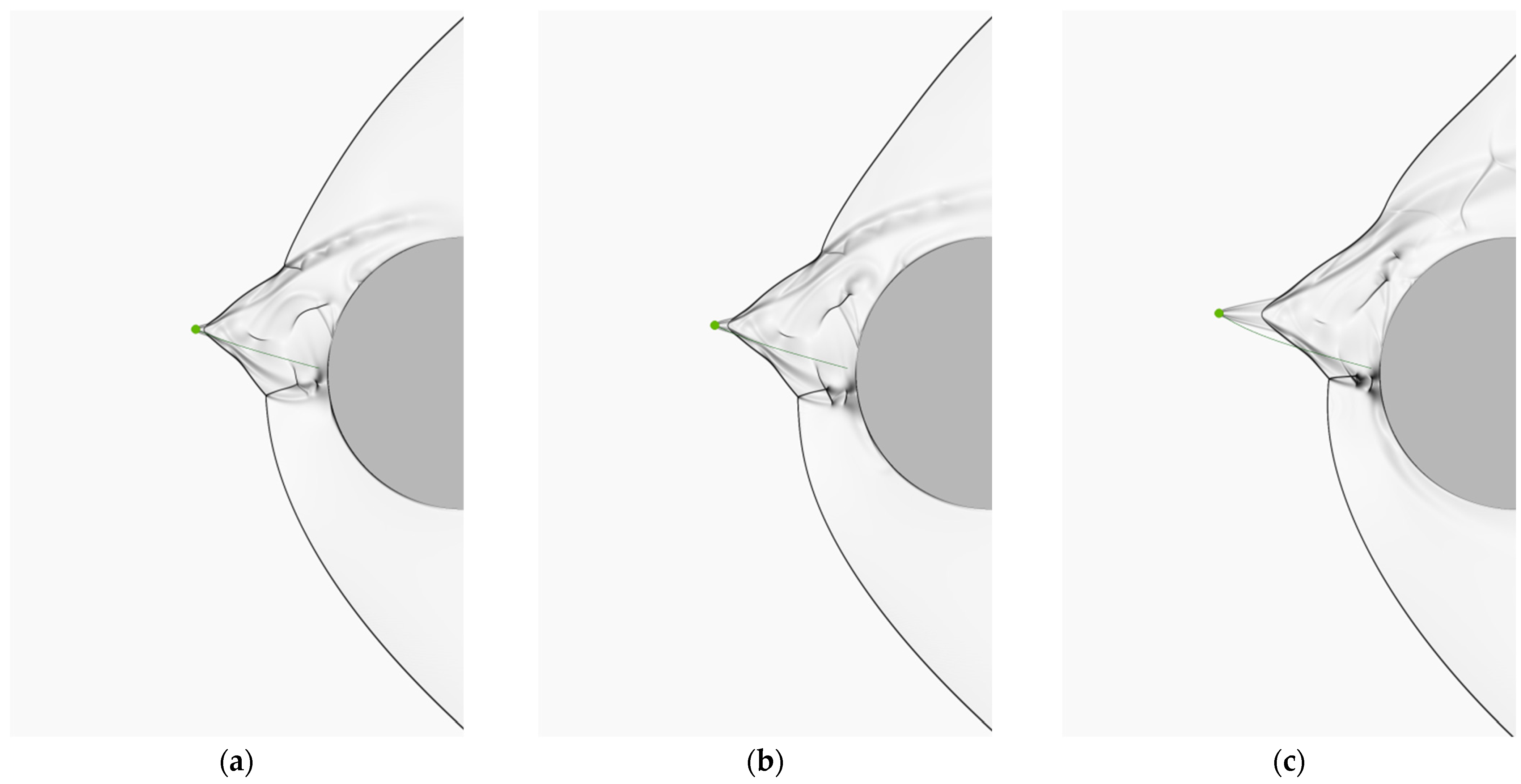
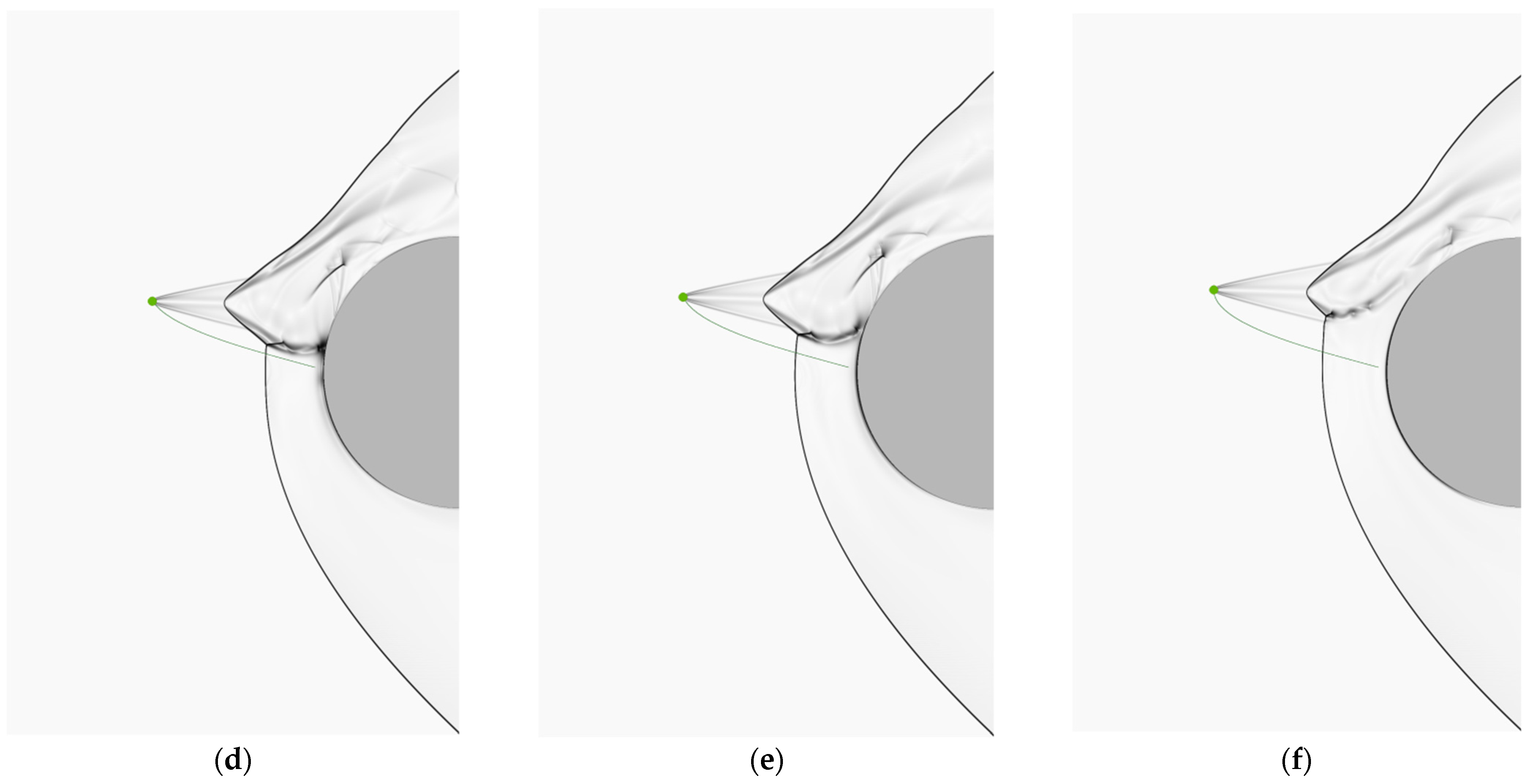
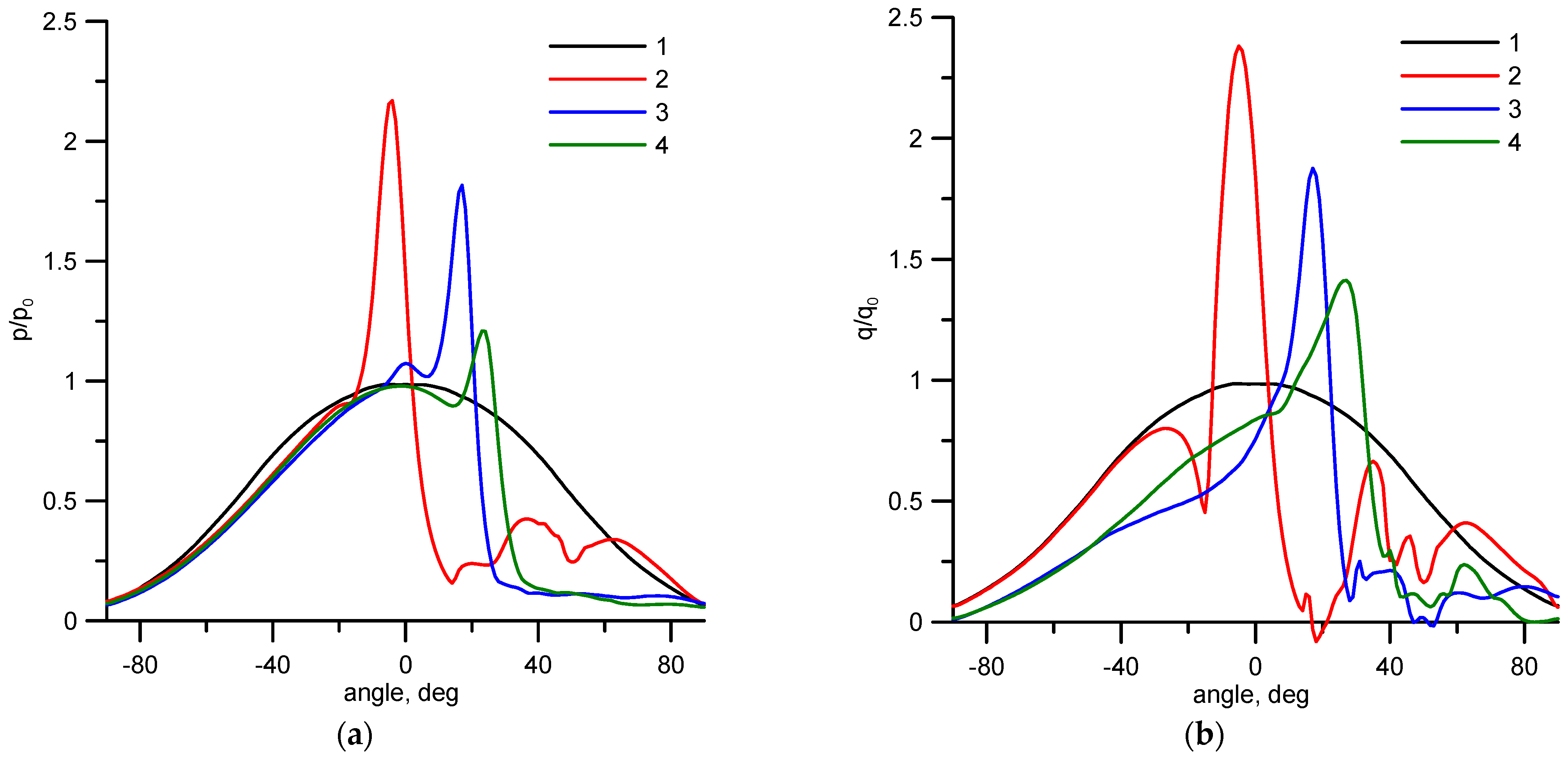
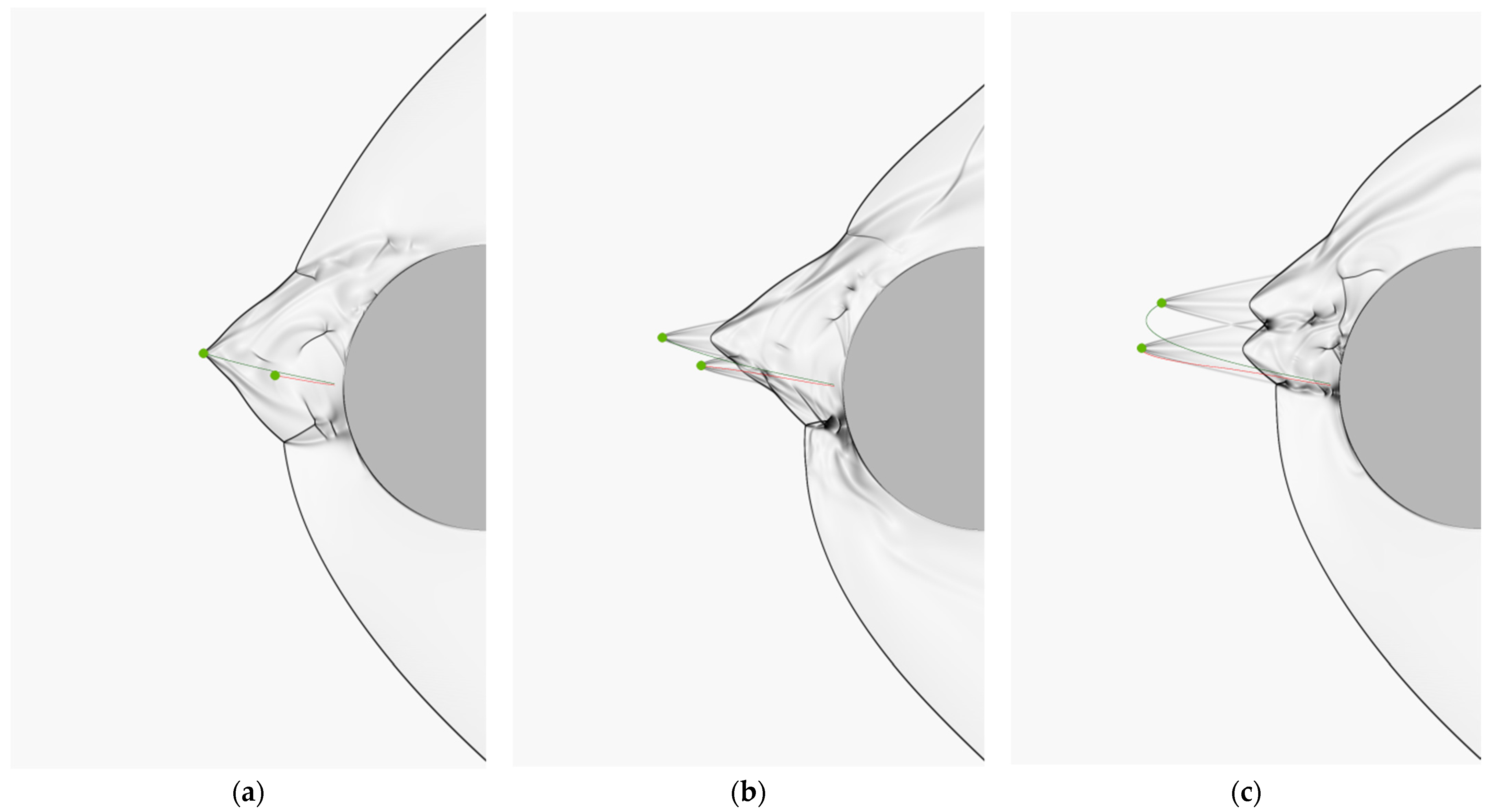
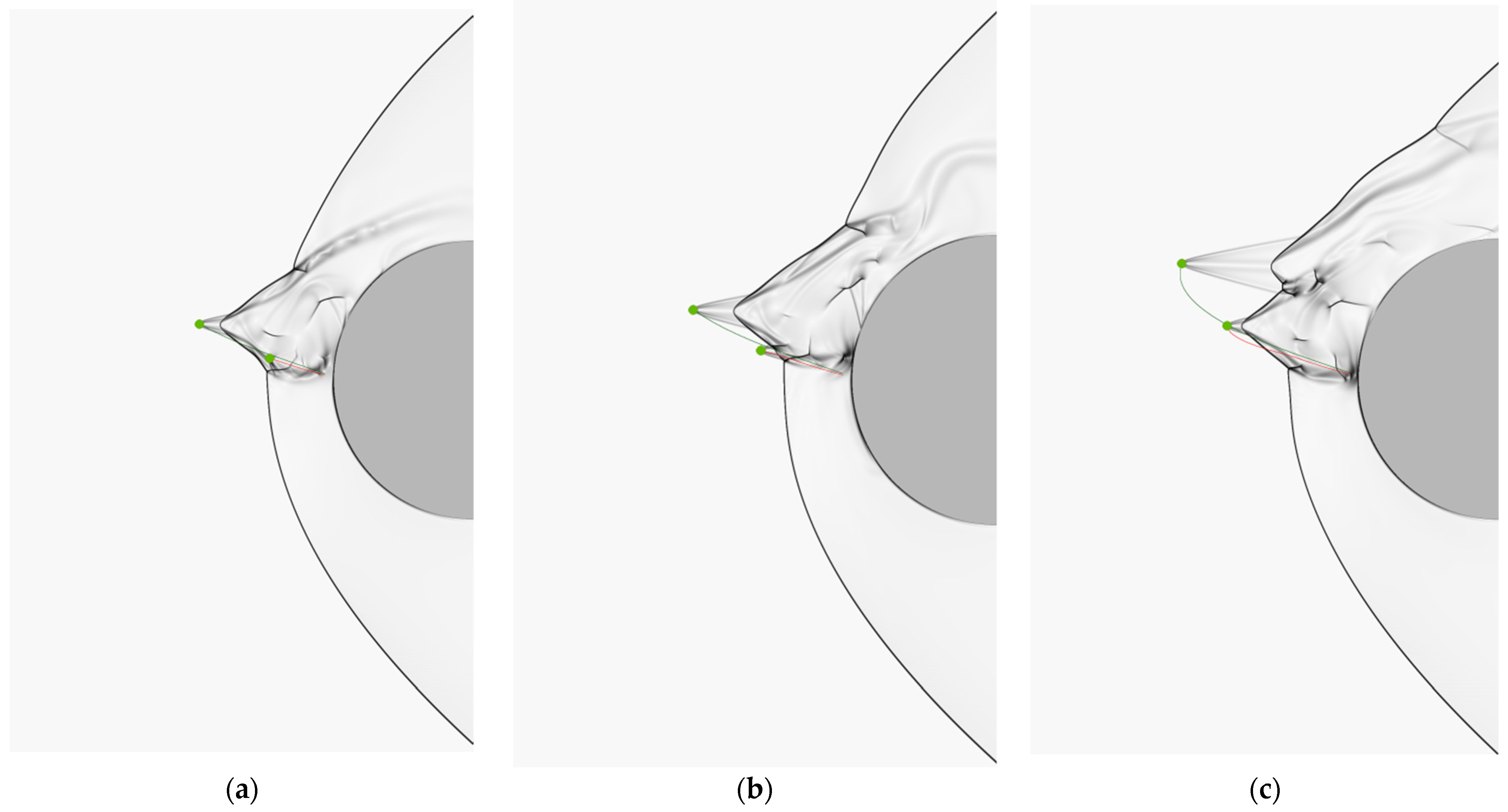
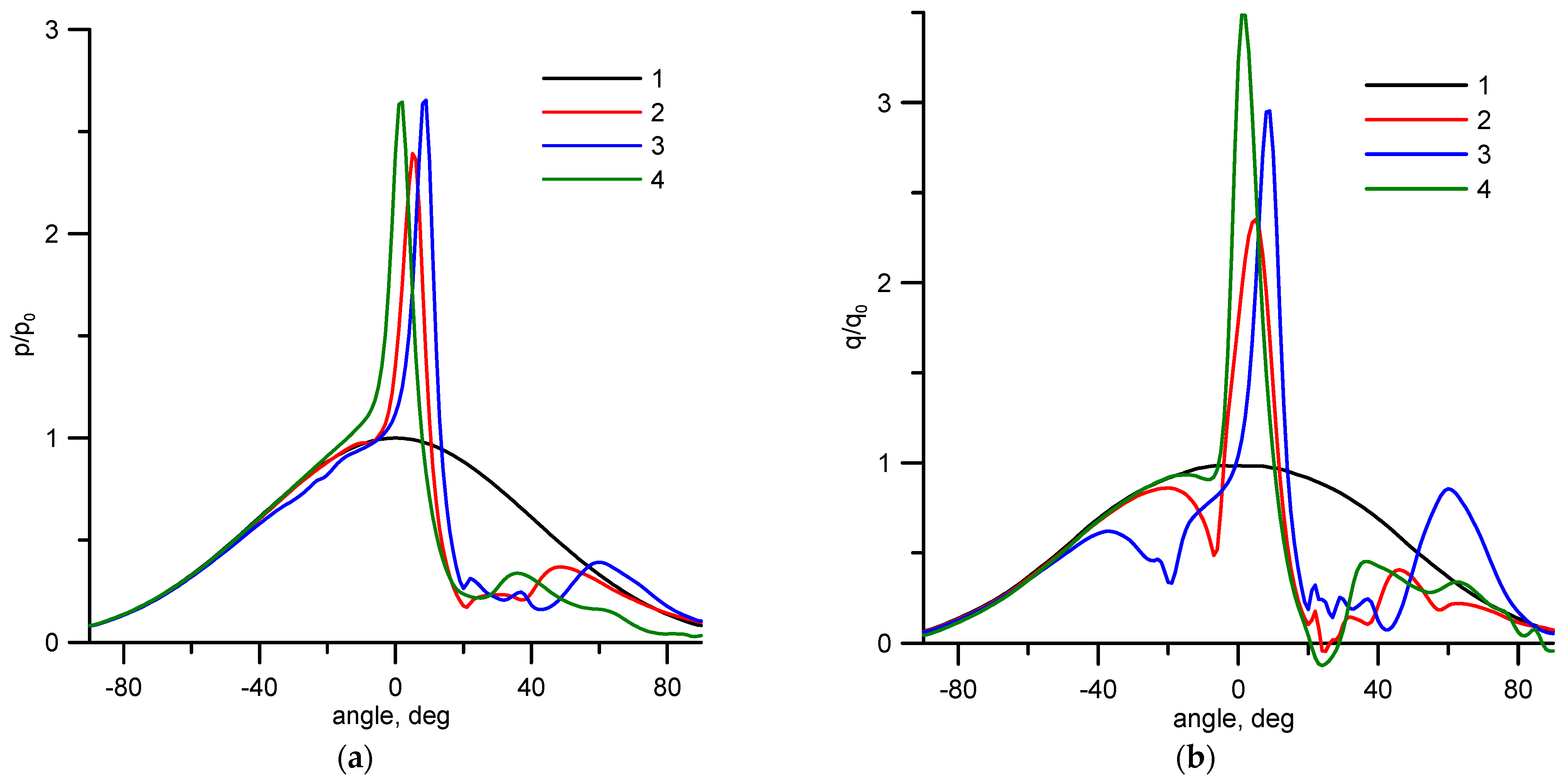


| Free Flow Parameters | Particle Parameters | ||
|---|---|---|---|
| Mach number | 6 | Diameter, mm | 0.2 |
| Reynolds number | 1.09 × 106 | Density, kg/m3 | 2170 |
| Cylinder diameter, mm | 75 | Initial velocity, m/s | 130–140 |
| Velocity, m/s | 1150 | ||
| Density, kg/m3 | 0.094 | ||
| Temperature, K | 89.3 | ||
Publisher’s Note: MDPI stays neutral with regard to jurisdictional claims in published maps and institutional affiliations. |
© 2021 by the authors. Licensee MDPI, Basel, Switzerland. This article is an open access article distributed under the terms and conditions of the Creative Commons Attribution (CC BY) license (https://creativecommons.org/licenses/by/4.0/).
Share and Cite
Sposobin, A.; Reviznikov, D. Impact of High Inertia Particles on the Shock Layer and Heat Transfer in a Heterogeneous Supersonic Flow around a Blunt Body. Fluids 2021, 6, 406. https://doi.org/10.3390/fluids6110406
Sposobin A, Reviznikov D. Impact of High Inertia Particles on the Shock Layer and Heat Transfer in a Heterogeneous Supersonic Flow around a Blunt Body. Fluids. 2021; 6(11):406. https://doi.org/10.3390/fluids6110406
Chicago/Turabian StyleSposobin, Andrey, and Dmitry Reviznikov. 2021. "Impact of High Inertia Particles on the Shock Layer and Heat Transfer in a Heterogeneous Supersonic Flow around a Blunt Body" Fluids 6, no. 11: 406. https://doi.org/10.3390/fluids6110406
APA StyleSposobin, A., & Reviznikov, D. (2021). Impact of High Inertia Particles on the Shock Layer and Heat Transfer in a Heterogeneous Supersonic Flow around a Blunt Body. Fluids, 6(11), 406. https://doi.org/10.3390/fluids6110406





